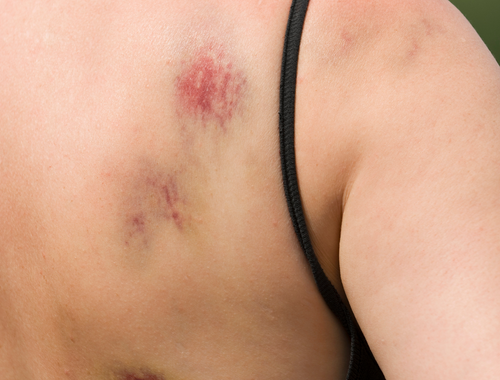Difference Between Ecchymosis and Petechiae
Ecchymosis is a patch of skin of at least 1 cm that is bruised. Petechiae are small dots of 3 mm or smaller, that are red or purple.

What is Ecchymosis?
Definition:
Ecchymosis is defined as a type of bruise that is quite big, at least 1 cm in size. It happens when blood vessels are damaged causing bleeding under the skin.
Causes:
Ecchymosis can result from some type of medical condition involving blood clotting, for instance, hemophilia or leukemia. Similarly, medicine that prevents clotting or an accident can also cause ecchymosis.
Diagnosis and symptoms:
Diagnosis of ecchymosis can be achieved through a physical exam where a large purple-colored patch on the skin is evident.
Complications:
Ecchymosis due to an injury should heal in time unless the condition is caused by an underlying disorder. If caused by an underlying illness, more ecchymosis may develop and more symptoms may appear.
Treatment:
Placing ice on ecchymosis is one way to treat the problem. If the ecchymosis is caused by an underlying disorder, then additional treatment is needed to manage the condition.

What is Petechiae?
Definition:
Petechiae are small (less than 3 mm) red or purple areas on the skin or mucus membranes that occur because of bleeding in small capillaries.
Causes:
There are many causes of petechiae, some more serious than others. Illnesses such as meningococcal disease, mononucleosis, thrombocytopenia, and even leukemia can manifest as petechiae. Certain infections such as endocarditis and Rocky Mountain Spotted fever can also have this as a symptom. Damage to the skin and blood clotting disorders can also produce these spots.
Diagnosis and symptoms:
Diagnosis is by a physical exam where tiny red or purple spots will be noted on the skin or in the mucus membranes. Additional symptoms may show that petechiae are a sign of a dangerous illness. The doctor needs to find the cause of the petechiae. To determine possible causes, blood tests including complete blood cell counts, white blood cell counts, and clotting times will be done. Testing for bacteria may also be important if an infection is suspected.
Complications:
Petechiae due to an illness may not easily go away, and additional symptoms like fever may appear. Petechiae may expand in size to form ecchymosis in patients with a blood-clotting disease.
Treatment:
Treatment depends on why the patient has petechiae. Nonsteroidal anti-inflammatory drugs (NSAIDs) are useful in treating the pain that comes with some illnesses. Cold packs can help with inflammation. Further treatment depends on the cause and may include antibiotic therapy in the case of infections.
Difference between Ecchymosis and Petechiae?
Definition
Ecchymosis is defined as patches of purple skin that are at least 1 cm or bigger than 1 cm. Petechiae are defined as spots that are red or purple that are less than 3 mm in size.
Causes
The reasons for ecchymosis may include illnesses like leukemia, hemophilia, injury to the skin, or blood clotting problems. There are multiple causes of petechiae including bacterial and viral infections, trauma to the skin, and the use of anti-clotting medicine.
Diagnosis
Medical history and physical exam can lead to a diagnosis of ecchymosis. Physical exam and blood tests can diagnose petechiae.
Symptoms
The sign of ecchymosis is a large flat purple area on the skin. The sign of petechiae is tiny dots that are red or purple that occur on the skin or mucus membranes.
Treatment
Ice packs treat ecchymosis. Petechiae can be treated using NSAIDs and ice packs and sometimes antibiotics.
Table comparing Ecchymosis and Petechiae

Summary of Ecchymosis Vs. Petechiae
- Ecchymosis is a much larger discolored area of skin compared with petechiae.
- Both ecchymosis and petechiae can be caused by some type of injury to the skin.
- It is important that a doctor find the cause of ecchymosis or petechiae because both problems can result from serious diseases, such as leukemia.
FAQ
What’s the difference between petechiae and purpura?
Petechiae are small red marks on the skin less than 3 mm in size. Although purpura, like petechia, are also areas of bleeding under the skin, purpura are larger in size and tend to be raised.
What is ecchymosis of the skin?
This is when there is a bruised area on the skin that is quite noticeable and at least 1 cm or larger in size.
What is the difference between ecchymosis and bruise?
An ecchymosis is a type of bruise that is equal to or bigger than 1 cm.
Is petechiae the same as a bruise?
Petechiae are not the same as a bruise but rather are tiny spots of bleeding under the skin and on mucus membranes that can even indicate a serious disease.
What causes ecchymosis?
Ecchymosis can happen because of a skin injury, use of certain anti-clotting medicine, or due to illnesses like leukemia or hemophilia.
What is livedo reticularis?
This is when the skin looks mottled because of a person being very cold.
- Difference Between Rumination and Regurgitation - June 13, 2024
- Difference Between Pyelectasis and Hydronephrosis - June 4, 2024
- Difference Between Cellulitis and Erysipelas - June 1, 2024
Search DifferenceBetween.net :
Leave a Response
References :
[0]Epperla, Narendranath, Joseph J. Mazza, and Steven H. Yale. "A review of clinical signs related to ecchymosis." WMJ 114.2 (2015): 61-5.
[1]McGrath, Ailbhe, and Michael J. Barrett. "Petechiae." StatPearls (2018).
[2]Modlin, John F., et al. "Case 25-2003: a newborn boy with petechiae and thrombocytopenia." New England Journal of Medicine 349.7 (2003): 691-700.
